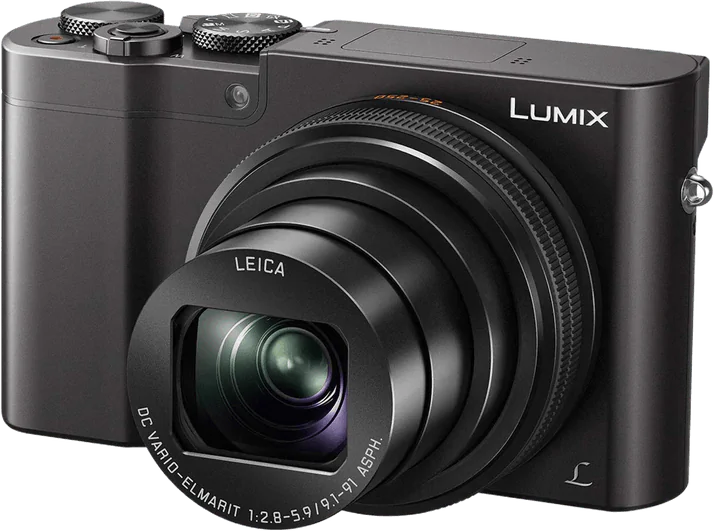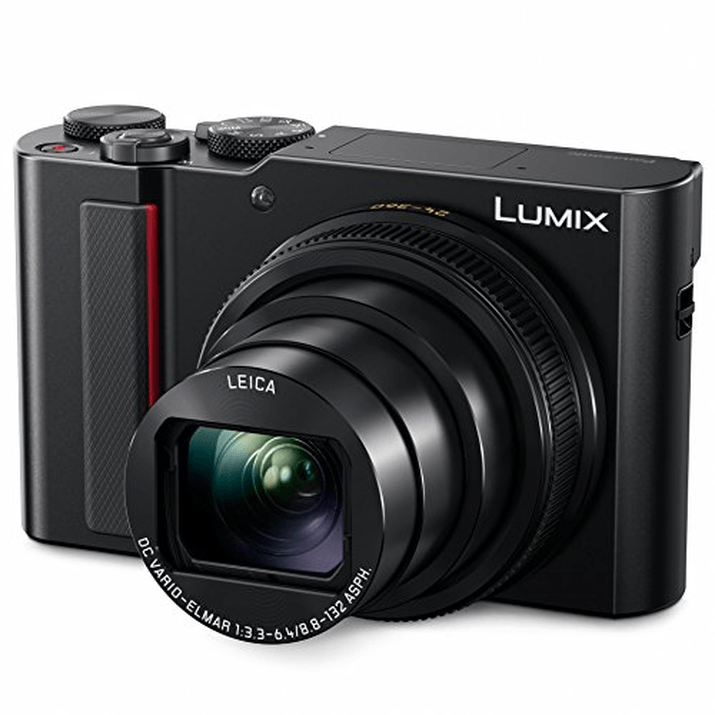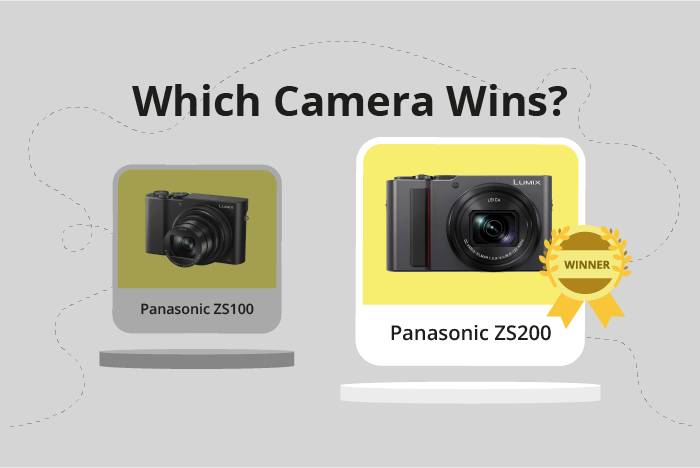Panasonic Lumix DMC ZS100 vs Lumix ZS200 (TZ200) Comparison
Panasonic Lumix DMC ZS100

Panasonic Lumix ZS200 / TZ200

The Panasonic Lumix ZS200 (TZ200) emerges as the winner with a score of 62/100, while the Panasonic Lumix DMC ZS100 trails behind at 58/100. Both cameras share similar characteristics, being compact in nature and having almost identical dimensions and weight.
The ZS200 outperforms the ZS100 in certain aspects, which contributes to its higher score. However, the ZS100 has its own advantages, such as a lower launch price of $699 compared to the ZS200’s $799.
Considering the four-point difference in scores and the shared specifications, the ZS200 offers better performance and features, justifying its higher price. On the other hand, the ZS100 still provides a solid option for those seeking a more budget-friendly camera without compromising too much on quality.
Panasonic Lumix DMC ZS100 vs Lumix ZS200 (TZ200) Overview and Optics
Upon comparing the Panasonic Lumix DMC ZS100 and the Panasonic Lumix ZS200 (TZ200), we found that both cameras have identical scores for their optics, standing at 61/100. This indicates that both cameras share several common specifications in terms of optics, which contribute to their equal scores.
Both cameras boast 20 megapixels, a shooting speed of 10, a CMOS sensor type, Venus Engine processors, and a DXOMARK score of 71 for their sensors. Additionally, both have a sensor size of 1″ and fixed lens mounts, meaning that the lenses cannot be changed. Lastly, both cameras come equipped with image stabilization features.
Although the optics scores are equal, there may be certain aspects where one camera outperforms the other. For the Panasonic Lumix DMC ZS100, it is important to consider its compact size and lighter weight, which could be advantageous for users who prioritize portability. On the other hand, the Panasonic Lumix ZS200 (TZ200) may excel in other areas, such as battery life or additional features, that are not directly related to optics.
Conversely, the Panasonic Lumix DMC ZS100 might fall short in certain areas where the Panasonic Lumix ZS200 (TZ200) excels. For example, the ZS200 might have better ergonomics or a more user-friendly interface, which could make it a more appealing choice for some users.
Taking all of these factors into account, it is clear that both the Panasonic Lumix DMC ZS100 and the Panasonic Lumix ZS200 (TZ200) have strong optics capabilities with identical scores. However, potential buyers should consider other factors, such as size, weight, and additional features, when deciding which camera best suits their needs.
Panasonic Lumix DMC ZS100 vs Lumix ZS200 (TZ200) Video Performance
The Panasonic Lumix ZS200 (TZ200) outperforms the Panasonic Lumix DMC ZS100 in video capabilities with a score of 83/100, a 14-point lead over the ZS100’s score of 69/100. Both cameras share common specifications, including 4K max video resolution, max video dimensions of 3840 x 2160, and a max video frame rate of 60fps.
The ZS200 (TZ200) boasts an advantage with its built-in time-lapse functionality, which the ZS100 lacks. This feature allows for the creation of stunning time-lapse videos without the need for additional software or equipment, making it a more versatile option for videographers.
The ZS100, however, does not offer any distinct advantages in video capabilities over the ZS200 (TZ200). Both cameras have identical video resolutions, dimensions, and frame rates, making the ZS100’s lower score a result of its missing time-lapse feature rather than any inherent superiority in other areas.
Given the comparison of video capabilities, the Panasonic Lumix ZS200 (TZ200) is the clear winner with its higher score and built-in time-lapse functionality. The ZS100 falls short in this aspect, offering no unique advantages to make up for its lower score. Thus, for those seeking a camera with superior video capabilities, the Panasonic Lumix ZS200 (TZ200) is the recommended choice.
Panasonic Lumix DMC ZS100 vs Lumix ZS200 (TZ200) Features and Benefits
The Panasonic Lumix ZS200 (TZ200) is the winner in this comparison, with a feature score of 70/100, while the Panasonic Lumix DMC ZS100 scored 57/100. Both cameras share common specifications, such as a 3-inch screen size, touchscreen capability, no flip screen, no GPS, and WIFI connectivity.
The ZS200 (TZ200) outperforms the ZS100 in several aspects. Firstly, it has a higher screen resolution of 1,240,000 dots, compared to the ZS100’s 1,040,000 dots. This difference provides a clearer and sharper display on the ZS200 (TZ200). Secondly, the ZS200 (TZ200) has Bluetooth connectivity, which the ZS100 lacks. This feature allows for seamless and easy connection to other devices, such as smartphones and tablets, for quick photo sharing and remote control capabilities.
The ZS100, however, does not offer any significant advantages over the ZS200 (TZ200). Both cameras have similar specifications, and the ZS200 (TZ200) surpasses the ZS100 in terms of screen resolution and Bluetooth connectivity. The ZS100’s lower feature score reflects this lack of advantages.
Taking all of these factors into account, the Panasonic Lumix ZS200 (TZ200) is the superior camera in terms of features. Its higher screen resolution and Bluetooth connectivity make it a more versatile and user-friendly option for photographers. The Panasonic Lumix DMC ZS100, while a capable camera, falls short in comparison to its counterpart.
Panasonic Lumix DMC ZS100 vs Lumix ZS200 (TZ200) Storage and Battery
The Panasonic Lumix ZS200 (TZ200) outperforms the Panasonic Lumix DMC ZS100 in storage and battery, with a score of 35/100 compared to the ZS100’s 29/100. Both cameras share common specifications, such as having one memory card slot and accepting SD, SDHC, and SDXC memory cards. Additionally, both cameras offer USB charging capabilities.
The ZS200 (TZ200) has an advantage in battery life, providing 370 shots compared to the ZS100’s 300 shots. Moreover, the ZS200 (TZ200) is compatible with UHS-I memory cards, allowing for faster data transfer speeds. The ZS100 does not offer any advantages in storage and battery over the ZS200 (TZ200).
Considering these points, the Panasonic Lumix ZS200 (TZ200) is the superior choice for those prioritizing storage and battery performance in their camera selection.
Alternatives to the Panasonic Lumix DMC ZS100 and Lumix ZS200 (TZ200)
Are you still undecided about which camera is right for you? Have a look at these popular comparisons that feature the Panasonic Lumix DMC ZS100 or the Panasonic Lumix ZS200 (TZ200):
- Panasonic Lumix ZS200 (TZ200) vs Sony Cyber-shot DSC-RX100 VII
- Canon PowerShot G7 X Mark III vs Panasonic Lumix ZS200 (TZ200)
- Canon PowerShot G7 X Mark III vs Panasonic Lumix DMC ZS100
- Fujifilm X-T20 vs Panasonic Lumix DMC ZS100
- Canon EOS R7 vs Panasonic Lumix ZS200 (TZ200)
- Canon PowerShot SX740 HS vs Panasonic Lumix ZS200 (TZ200)

